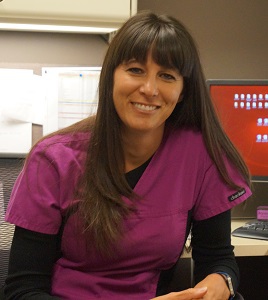
The respiratory care profession can take you in many different directions, and in recent years one path that’s grown in popularity is the physician’s office. In most cases, pulmonologists recruit RTs so they can offer state-of-the-art pulmonary function testing onsite, relieving their patients of the need to go to an acute care facility for the tests they need to diagnose and monitor their conditions.

That’s how Tami Jurgens, RRT, first came to Nebraska Pulmonary Specialties in Lincoln 14 years ago.
“I was approached by one of our physicians about the open position,” she said. At the time, she had never really considered working anywhere but the hospital, but the job sounded interesting and she decided to give it a chance.
Multiple hats
Today Jurgens is director of clinical services for the 13-physician practice, a job that requires her to wear multiple hats.
“I really never know what each day will bring, but most of the time my day consists of interviewing and hiring new staff, troubleshooting things that come up in the moment, and helping out where it is needed,” she said.
She also assists with staff training across clinical and nonclinical environments, works with her colleagues to establish protocols for the office, and ensures safety and adherence to OSHA standards.
“Another part of my role is communicating with the physicians and executing the plan of how they envision their clinic to operate,” she said. Improving communication among the wide range of staff employed by the practice is a key concern as well.
“We have over 80 staff, so making sure everyone is on the same page and receives all necessary communication can be challenging sometimes,” she said. “Communication is also very important when it comes to patient care. We need to be sure we communicate with them, so they know what to expect when they arrive.”
Weighing the options
Would she recommend the physician office setting to her peers in respiratory care? Jurgens answers with a qualified yes.
“For me personally, it was a good change, but it is very different than working in a hospital environment,” she cautions. For one thing, she works five days a week, which means she gave up the flexibility in scheduling that comes with 12 hour shifts and more days off each week.
Of course, she notes she did gain weekends and holidays, since the clinic is closed those days.
Patient care is different too.
“You get to see a new side of patient care working in outpatient instead of inpatient,” Jurgens said. She emphasizes therapists in her setting still need to use the assessment and critical thinking skills they developed in the hospital, but there are many different scenarios that may arise with patients that they might not have seen on the inpatient side. “You need to adjust based on their condition or level of understanding,” she said.
Positive feedback
So, bottom line, it can be a tradeoff — but for therapists like Jurgens, the physician’s office can offer a new and exciting environment that brings a different but equal level of job satisfaction.
The best part of the job? Hearing positive feedback from patients who come to the clinic for care.
“Knowing we have helped them or changed their quality of life for the better is the biggest reward,” she said.
Find out how you can get your foot in the door of the physician’s office by downloading the AARC’s free Market Yourself to the Physician Practice toolkit.





